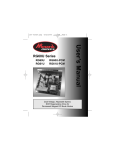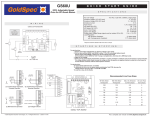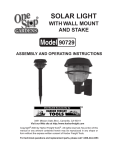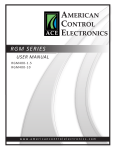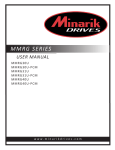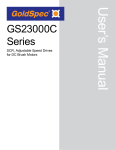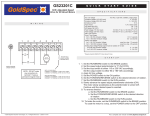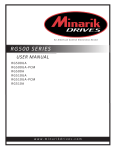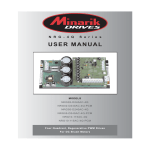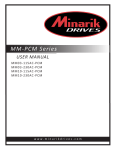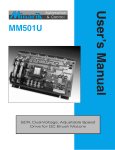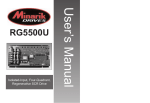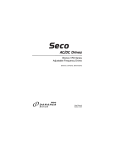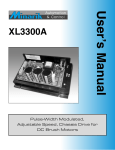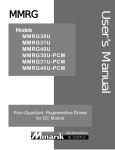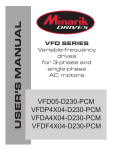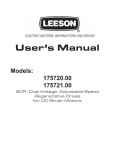Download User Manual - Applied Industrial Technologies
Transcript
DUAL VOLTAGE, ADJUSTABLE SPEED, SCR REGENERATIVE DRIVE FOR PERMANENT MAGNET DC BRUSH MOTORS User’s Manual GS60U Safety Warnings SHOCK HAZARD AVOID HEAT KEEP DRY Contents AVOID VIBRATION • This symbol denotes an important safety tip or warning. Please read these instructions carefully before performing any of the procedures contained in this manual. • DO NOT INSTALL, REMOVE, OR REWIRE THIS EQUIPMENT WITH POWER APPLIED. Have a qualified electrical technician install, adjust and service this equipment. Follow the National Electrical Code and all other applicable electrical and safety codes, including the provisions of the Occupational Safety and Health Act (OSHA), when installing equipment. • Reduce the chance of an electrical fire, shock, or explosion by proper grounding, over-current protection, thermal protection, and enclosure. Follow sound maintenance procedures. WARNING It is possible for a drive to run at full speed as a result of a component failure. Manufacturer strongly recommends the installation of a master switch in the main power input to stop the drive in an emergency. Circuit potentials are at 115 VAC or 230 VAC above Earth ground. Avoid direct contact with the printed circuit board or with circuit elements to prevent the risk of serious injury or fatality. Use a non-metallic screwdriver for adjusting the calibration trimpots. Use approved personal protective equipment and insulated tools if working on this drive with power applied. 2 Regenerative Drives . . . . . . . . . . . . . . . . . . . . . . . . . . . . . . . . . 3 Specifications . . . . . . . . . . . . . . . . . . . . . . . . . . . . . . . . . . . . . . 3 Dimensions . . . . . . . . . . . . . . . . . . . . . . . . . . . . . . . . . . . . . . . . 4 Installation . . . . . . . . . . . . . . . . . . . . . . . . . . . . . . . . . . . . . . . . 4 Mounting . . . . . . . . . . . . . . . . . . . . . . . . . . . . . . . . . . . . . . . . . 4 Wiring . . . . . . . . . . . . . . . . . . . . . . . . . . . . . . . . . . . . . . . . . . . . 5 Shielding guidelines . . . . . . . . . . . . . . . . . . . . . . . . . . . . . . . 5 Heat sinking . . . . . . . . . . . . . . . . . . . . . . . . . . . . . . . . . . . . . . . 5 Line fusing . . . . . . . . . . . . . . . . . . . . . . . . . . . . . . . . . . . . . . . . 5 Speed adjust potentiometer . . . . . . . . . . . . . . . . . . . . . . . . . . . 5 Connections . . . . . . . . . . . . . . . . . . . . . . . . . . . . . . . . . . . . . . . 6 Power, fuse and motor connections . . . . . . . . . . . . . . . . . . . 6 Voltage follower (isolated signal) . . . . . . . . . . . . . . . . . . . . . . . 7 Line voltage switches . . . . . . . . . . . . . . . . . . . . . . . . . . . . . . . . 7 Armature voltage switch . . . . . . . . . . . . . . . . . . . . . . . . . . . . . . 7 Feedback selector switch . . . . . . . . . . . . . . . . . . . . . . . . . . . . . 7 Operation . . . . . . . . . . . . . . . . . . . . . . . . . . . . . . . . . . . . . . . . . . 8 Before applying power: . . . . . . . . . . . . . . . . . . . . . . . . . . . . . . 8 Startup and shutdown . . . . . . . . . . . . . . . . . . . . . . . . . . . . . . . 8 To start the drive: . . . . . . . . . . . . . . . . . . . . . . . . . . . . . . . . . 8 Starting and Stopping Methods . . . . . . . . . . . . . . . . . . . . . . . . 8 Automatic restart upon power restoration . . . . . . . . . . . . . . . 8 Decelerate to a stop . . . . . . . . . . . . . . . . . . . . . . . . . . . . . . . 8 Coast to a stop . . . . . . . . . . . . . . . . . . . . . . . . . . . . . . . . . . . 8 Regenerative brake . . . . . . . . . . . . . . . . . . . . . . . . . . . . . . . 8 Invert Inhibit and Invert Enable . . . . . . . . . . . . . . . . . . . . . . . 9 Calibration . . . . . . . . . . . . . . . . . . . . . . . . . . . . . . . . . . . . . . . . 10 MINIMUM SPEED (MIN SPD) . . . . . . . . . . . . . . . . . . . . . . . . 10 MAXIMUM SPEED (MAX SPD) . . . . . . . . . . . . . . . . . . . . . . . 10 FORWARD TORQUE (FWD TQ) . . . . . . . . . . . . . . . . . . . . . . 10 REVERSE TORQUE (REV TQ) . . . . . . . . . . . . . . . . . . . . . . . 11 IR COMPENSATION (IR COMP) . . . . . . . . . . . . . . . . . . . . . . 11 FORWARD ACCELERATION (FWD ACC) . . . . . . . . . . . . . . 11 REVERSE ACCELERATION (REV ACC) . . . . . . . . . . . . . . . 11 DEADBAND (DB) . . . . . . . . . . . . . . . . . . . . . . . . . . . . . . . . . . 12 TACH GENERATOR (TACH) . . . . . . . . . . . . . . . . . . . . . . . . . 12 Application Notes . . . . . . . . . . . . . . . . . . . . . . . . . . . . . . . . . . 13 Connections to GoldSpec™ GS600 . . . . . . . . . . . . . . . . . . . . 13 FWD-REV switch . . . . . . . . . . . . . . . . . . . . . . . . . . . . . . . . . . 13 FWD-STOP-REV switch . . . . . . . . . . . . . . . . . . . . . . . . . . . . . 13 Independent Adjustable Speeds . . . . . . . . . . . . . . . . . . . . . . 13 Independent forward and reverse speeds . . . . . . . . . . . . . . . 14 Independent forward and reverse speeds with FWD-STOP-REV switch . . . . . . . . . . . . . . . . . . . . . . . . . 14 Troubleshooting . . . . . . . . . . . . . . . . . . . . . . . . . . . . . . . . . . . 14 Before applying power . . . . . . . . . . . . . . . . . . . . . . . . . . . . . . . . 14 GoldSpec™ User’s Manual 1 Specifications Specifications Model Regenerative Drives Armature Current Range (ADC) Armature Horsepower 5.0* 1/4 - 1/2* 0 - 90 5.0** 1/4 – 1** 0 – 180 GS60U Most non-regenerative, variable speed, DC drives control current flow to a motor in one direction. The direction of current flow is the same direction as the motor rotation. Non-regenerative drives operate in Quadrant 1, and also in Quadrant 3 if the drive is reversible (see Figure 1, below). Motors must stop before reversing direction. Unless dynamic braking is used, non-regenerative drives cannot decelerate a load faster than coasting to a lower speed. Voltage Range (VDC) * Max. Armature Current = 10 ADC and Max. Horsepower = 1 hp when mounted to heat sink kit part number GS223-0159. ** Max. Armature Current = 10 ADC and Max. Horsepower = 2 hp when mounted to heat sink kit part number GS223-0159. AC Line Voltage 115 VAC / 230 VAC, ±10%, 50/60 Hz, single phase Form Factor 1.37 at base speed Acceleration Time Range 0.5 – 6 seconds Deceleration Time Range 0.5 – 6 seconds Analog Input Voltage Range (signal must be isolated; S0 to S2) Input Impedance (S0 to S2) Regenerative drives operate in two additional quadrants: Quadrant 2 and Quadrant 4. In these quadrants, motor torque is in the opposite direction of motor rotation. 0 to +/- 10 VDC vi 30 kohms This allows regenerative drives to reverse a motor without contactors or switches, to control an overhauling load, and Regenerative Drives to decelerate a load faster than it would take to coast to a lower speed. Load Regulation with Armature Feedback with Tachogenerator Feedback Vibration 1% base speed 0.1% base speed 0.5G max. (20–50 Hz) 0.1G max. (> 50 Hz) Ambient Temperature Range Weight 10°C – 55°C 1.1 lb Tables Table 1. Recommended Line Fuse Sizes . . . . . . . . . . . . . . . . . . . . . . . . . 5 Quadrant II Quadrant I Quadrant III Quadrant IV Illustrations Figure 1 Four Quadrant Operation . . . . . . . . . . . . . . . . . . . . . . . . . . . . . . 3 Figure 2 GS60U Dimensions. . . . . . . . . . . . . . . . . . . . . . . . . . . . . . . . . . . 4 Figure 4 Speed Adjust Potentiometer. . . . . . . . . . . . . . . . . . . . . . . . . . . . 5 Figure 5 Screw Terminal Block . . . . . . . . . . . . . . . . . . . . . . . . . . . . . . . . . 6 Figure 6 Cage-Clamp Terminal Block. . . . . . . . . . . . . . . . . . . . . . . . . . . . 6 Figure 7 Power and Motor Connections (Bottom Board). . . . . . . . . . . . . 6 Figure 8 Speed Adjust Potentiometer Connections. . . . . . . . . . . . . . . . . . 7 Figure 9 Voltage Follower Connection. . . . . . . . . . . . . . . . . . . . . . . . . . . 7 Figure 10 Line Voltage Switches (bottom board). . . . . . . . . . . . . . . . . . . 7 Figure 11 Armature Voltage and Feedback Selector Switch Locations (top board). . . . . . . . . . . . . . . . . . . . . . . . . . . . 7 Figure 13 RUN/STOP Switch . . . . . . . . . . . . . . . . . . . . . . . . . . . . . . . . . . 8 Figure 14 INHIBIT / ENABLE Terminal TB503 and JP502 Locations. . . . . . . . . . . . . . . . . . . . . . . . . . . . . . . . . . . . . . . . . 9 Figure 15 INHIBIT Settings. . . . . . . . . . . . . . . . . . . . . . . . . . . . . . . . . . . . 9 Figure 16 ENABLE Settings . . . . . . . . . . . . . . . . . . . . . . . . . . . . . . . . . . . 9 Figure 17 GS60U Calibration Trimpot Locations. . . . . . . . . . . . . . . . . . . 10 Figure 18 Deadband Settings. . . . . . . . . . . . . . . . . . . . . . . . . . . . . . . . . 12 Figure 19 Typical FWD TQ, REV TQ, and IR COMP Trimpot Settings . . . . . . . . . . . . . . . . . . . . . . . . . . . . . . . . . . . 13 Figure 21 GS60U Connections to GS600. . . . . . . . . . . . . . . . . . . . . . . . 13 Figure 22 Forward-Reverse Switch. . . . . . . . . . . . . . . . . . . . . . . . . . . . . 13 Figure 23 Forward-Stop-Reverse Switch . . . . . . . . . . . . . . . . . . . . . . . . 13 Figure 24 Independent Adjustable Speeds (Forward Direction). . . . . . . . . . . . . . . . . . . . . . . . . . . . . . . . . . . . . . . . . 13 Figure 25 Independent Forward and Reverse Speeds. . . . . . . . . . . . . . 14 Figure 26 Independent Forward and Reverse Speeds with a Forward-Stop-Reverse Switch. . . . . . . . . . . . . . . . . . . . . . . . . . . . . . . 14 GS60U MOTOR ROTATION MOTOR TORQUE NOTE: ARROWS IN SAME DIRECTION = MOTOR ACTION ARROWS IN OPPOSITE DIRECTION = REGENERATIVE ACTION Figure 1. Four Quadrant Operation Figure 1. Four Quadrant Operation 3 2 Dimensions Dimensions Installation Mounting 2.55 [65] JP502 IC504 C504 C503 IC501 INVERT INHIBIT INVERT ENABLE IL501 IL502 IC502 IC503 TB503 LIMIT FWD REV FWD TQ A2 ENABLE REV TQ Do not install, rewire, or remove this control with input power applied. Doing so may cause fire or serious injury. Make sure you have read and understood the Safety Warnings on page i before attempting installation. A1 C501 0.19 [5] INHIBIT IR COMP Y501 GND MAX SPD TB502 L1 WARNING C502 REV ACC 3.70 [94] SW503 FWD ACC L2 FEEDBACK ARM-TACH SW504 ARMATURE 90-180 DB MIN SPD IL503 S0 S1 S2 S3 +15V -15V RB2 T1 T2 0.71 [18] TB501 0.80 [20] RB1 POWER TACH T501 HEATSINK DIMENSIONS (optional) 6.9 x 4.4 x 1.0 1.96 [50] • Protect the drive from dirt, moisture, and accidental contact. 0.19 [5] 1.66 [42] 3.80 [97] 4.30 [109] ALL DIMENSIONS IN INCHES [MILLIMETERS] Figure 2. RG60U/RG61U Dimensions Figure 2. GS60U Dimensions • Drive components are sensitive to electrostatic fields. Avoid direct contact with the circuit board. Hold drive by the chassis only. • Provide sufficient room for access to the terminal block and calibration trimpots. • Mount the drive away from heat sources. Operate the drive within the specified ambient operating temperature range. • Prevent loose connections by avoiding excessive vibration of the drive. • Mount drive with its board in either a horizontal or vertical plane. Six 0.19 in. (5 mm) wide slots in the chassis accept #8 pan head screws. Fasten either the large base or the narrow flange of the chassis to the subplate. • The chassis should be earth grounded. Use a star washer beneath the head of at least one of the mounting screws to penetrate the anodized chassis surface and to reach bare metal. Wiring WARNING Do not install, rewire, or remove this control with input power applied. Failure to heed this warning may result in fire, explosion, or serious injury. Circuit potentials are at 115 or 230 VAC above ground. To prevent the risk of injury or fatality, avoid direct contact with the printed circuit board or with circuit elements. Do not disconnect any of the motor leads from the drive unless power is removed or the drive is disabled. Opening any one motor lead while the drive is running may destroy the drive. • Use 18 AWG wire for speed adjust potentiometer wiring. Use 14 AWG wire for AC line (L1, L2) and motor (A1, A2) wiring. 4 GoldSpec™ User’s Manual Line fusing Shielding guidelines GoldSpec™ drives should be used with fuses for protection. Use fast acting fuses rated for 250 VAC or higher. Fuse L1 only when the line voltage is 115 VAC. Fuse both L1 and L2 when the line voltage is 230 VAC. WARNING Under no circumstances should power and logic leads be bundled together. Induced voltage can cause unpredictable behavior in any electronic device, including motor controls. The table below lists the recommended line fuse sizes. Installation 8 As a general rule, manufacturer recommends shielding of all conductors. Table 1. Recommended Line Fuse Sizes Table 1. Recommended Line Fuse Sizes If it is not practical to shield power conductors, manufacturer recommends shielding all logic-level leads. If shielding of all logic-level leads is not practical, the user should twist all logic leads with themselves to minimize induced noise. It may be necessary to earth ground the shielded cable. If noise is produced by devices other than the drive, ground the shield at the drive end. If noise is generated by a device on the drive, ground the shield at the end away from the drive. Do not ground both ends of the shield. If the drive continues to pick up noise after grounding the shield, it may be necessary to add AC line filtering devices, or to mount the drive in a less noisy environment. 90 VDC Motor Horsepower 180 VDC Motor Horsepower Max. DC Armature Current (amps) AC Line Fuse Size (amps) 1/20 1/15 1/10 0.5 3 1/8 0.8 3 1/8 1/4 1.5 5 1/6 1/3 1.75 5 1/4 1/2 2.5 8 1/3 3/4 3.5 8 1/2 1 5.0 10 3/4 1 1/2 7.5 15 1 2 10 20 Minarik Corporation offers two fuse kits: part number 050–0069 (3–8A Fuse adjust Kit) and 050–0073 (5–20A Fuse Kit). Installation Speed potentiometer Logic wires from other input devices, such as motion controllers and PLL velocity controllers, must be separated from power lines in the same manner as the logic I/O on this drive. 9 Speed adjust potentiometer WARNING Heat sinking The GS60U drive requires an additional heat sink when the continuous armature current is above 5 ADC. Use GoldSpec™ heat sink kit part number GS223-0159. Use a thermally conductive heat sink compound (such as Dow Corning® 340 Heat Sink compound) between the drive chassis and the heat sink surface for optimum heat transfer. Be sure that the potentiometer tabs do not make contact with the potentiometer enclosure. Grounding � Warning willpotentiometer cause damage Be the sureinput that the tabstodothe notdrive. make contact with the potentiometer enclosure. Grounding the input will cause damage to the drive. Mount the speed adjust potentiometer through a 0.38 in. (10 mm) hole with the hardware provided (Figure 4). Install Mount the speed adjust potentiometer a 0.38 in.the (10 10K mm) the circular insulating disk betweenthrough the panel and hole with the hardware provided (Figure 4). Install the circular ohm speed adjust potentiometer. insulating disk between the panel and the 10K ohm speed adjust potentiometer. Twist the speed adjust potentiometer wire to avoid picking up unwanted electrical noise. If speed adjust potentiometer Twist the adjust wireuse to avoid picking up wires arespeed longer thanpotentiometer 18 in. (46 cm), shielded cable. unwanted electrical noise. If speed adjust potentiometer wires are Keep speed adjust potentiometer wires separate from power longer than 18 in. (46 cm), use shielded cable. Keep speed adjust leads (L1, L2, A1, A2). potentiometer wires separate from power leads (L1, L2, A1, A2). MOUNT THROUGH A 0.38 IN. (10 MM) HOLE CW WIPER W NUT STAR WASHER SPEED ADJUST POTENTIOMETER INSULATING DISK PANEL Figure Potentiometer Figure4.4.Speed SpeedAdjust Adjust Potentiometer GS60U 5 Connections Screw terminal block Wire Clamp Connections Mostterminal connections to the Screw block RG60U drive are made to a Screw terminal screw terminalblock block (part Most tothe the Most connections connections number 164-0370).to Using a GS60U drive are made RG60U drive are made to a screwdriver, turn the terminal toscrew a screw terminal terminal block block. (part block screw counterclockwise Using a screwdriver, turna number 164-0370). Using to open the wire clamp. screwdriver, turn thescrew terminal the terminal block Insert 18 AWG stripped wire blockthe screw counterclockwise open into wire counterclockwise clamp.toTurn the to open wire clamp. terminal block screw the wire the clamp. Insert Insert 18 stripped AWG stripped wire clockwise to clamp the wire. 18 AWG wire into the wire clamp. Turn the into the wire clamp. Turn terminal block screw the terminal block screw clockwise to clamp the wire. clockwiseterminal to clamp block the Cage-clamp wire. Wire Clamp Connect a DC motor to PCB terminals A1 and A2 as shown in Figure 7, page 6. Ensure that the motor voltage rating is consistent with the drive’s output voltage. Screw Figure 5. Screw Terminal Block Screw Figure 5. Screw Terminal Block Inhibit and enable wire clamp in front of the terminal block. Release the lever arm to clamp the wire. Power input Connect the AC line power leads to terminals L1 and L2, or to a double-throw, single-pole master power switch (recommended). Line fuse Cage-clamp terminal block connections are made to a Cage-clamp cage-clamp terminal block. To terminal block Inhibit insert aand wireenable into the terminal connections made to a block, press are down on the cage-clamp terminal block. To Inhibit andusing enable lever arm a small insert a wire Insert into connections are the made to a screwdriver. 20terminal AWG block, press on wire the stripped wiredown into the cage-clamp terminal block. lever arm small clamp in front ofathe terminal To insert ausing wire into the screwdriver. Insert 20 AWG block. Release the lever arm terminal block, press down stripped wire into the wire to clamp the wire. on the lever arm using a clamp in front of the terminal small screwdriver. Insert 20 block. Release the lever arm AWG stripped wire into the to clamp the wire. GoldSpec™ drives supply motor voltage from A1 and A2 terminals. It is assumed throughout this manual that, when A1 is positive with respect to A2 , the motor will rotate clockwise (CW) while looking at the output shaft protruding from the front of the motor. If this is opposite of the desired rotation, simply reverse the wiring of A1 and A2 with each other (A1 - and A2 +). Lever Arm Wire Clamp Lever Arm Wire an external line fuse between the stop switch (if installed) and the terminal board (Figure 7, page 6). An additional line fuse should be installed on L2 if the input voltage is 230 VAC. Refer to the line fuse table (Table 1 on page 5) for fuse ratings. GS60U BOTTOM BOARD RG60U BOTTOM BOARD Wire Clamp Figure 6. Cage-Clamp Terminal Block * NOTE ADD FUSE TO L2 WITH 230 VAC INPUT ONLY Figure 6. Cage-Clamp Terminal Block L2 SCR504 SCR508 SCR507 SCR506 SCR505 SCR501 C507 C506 T502 SCR502 T505 T504 A1 T503 A2 GND FUSE* WARNING MOTOR MOV501 Power, fuse and motor connections Connect the power input leads, an external line fuse and a DC motor to the drive’s printed circuit board (PCB) as shown in Figure 7. C502 FUSE C501 EARTH GROUND 115-230 SW502 230-115 T501 AC LINE INPUT 115 or 230 VAC Figure 7. Power Motor Connections (Bottom Board) Figure 7. Power andand Motor Connections (Bottom Board) Speed adjust potentiometer connections The motor can operate in one direction (unidirectional) or two directions (bidirectional) depending on how the speed adjust potentiometer is connected to the drive. Connect the speed adjust potentiometer as shown in Figure 8(a), page 7 for bidirectional operation. The motor does not operate when the wiper is in the center position. Turning the wiper clockwise (CW) from the center position causes the motor to rotate in one direction, while turning the wiper counterclockwise (CCW) causes rotation in the opposite direction. GoldSpec™ User’s Manual 13 Manufacturer strongly recommends the installation of a master power switch in the voltage input line, as shown in Figure 7, page 6. The switch contacts should be rated at a minimum of 200% of motor nameplate current and 250 volts. C503 Installation Do not connect this equipment with power applied. Failure to heed this directive may result in fire or serious injury. 6 SCR503 R18 Installation Motor C510 10 Installation (continued) Connections C509 Installation TB501 10 Installation 17 Line voltageswitches switches Line voltage Connect the speed adjust potentiometer as shown in Figure 8(b), page 7 for unidirectional operation in the forward direction. SW501 and onon thethe bottom board are the SW501 andSW502 SW502 bottom board areline thevoltage line voltage switches (see Figure 10). Set the switches to 115 VAC the line switches (see Figure 10). Set the switches to 115 ifVAC if the voltage is 115 VAC, or to 230 VAC if the line voltage is line voltage is 115 VAC, or to 230 VAC if the line voltage is 230 VAC. 230 VAC. Connect the speed adjust potentiometer as shown in Figure 8(c), page 7 for unidirectional operation in the reverse direction. 15 Installation Refer to the Application Notes section for additional speed adjust potentiometer connections. SCR503 SCR504 SCR508 SCR507 SCR506 SCR505 SCR501 R18 T2 SCR502 T1 L2 RB2 REV S3 A2 C509 S1 S0 MOV501 TB501 C502 SW501 (a) Bidirectional Operation C501 T2 T2 T1 T1 RB1 RB1 RB2 -15V 10K OHM SPEED POT FWD +15V CW A1 T503 GND S2 FWD T505 T504 L1 +15V CW C507 C506 T502 -15V 10K OHM SPEED POT C510 RB1 (115 VAC or 230 VAC) RB2 CW +15V -15V S3 S3 S2 S2 S1 S1 S0 S0 TB501 TB501 T501 230-115 Line Voltage Switches SW501 & SW502 10K OHM SPEED POT REV 115-230 SW502 Figure 10.10.Line Voltage (bottom board) Figure Line Voltage Switches Switches (bottom board) Installation 18 Armature voltage switch Armature voltage switch SW504 on the top board is the armature voltage selector (b) Unidirectional Operation, (c) Unidirectional Operation, Forward Direction Reverse Direction 16 Installation Figure 8. Speed Adjust Potentiometer Connections Figure 8. Speed Adjust Potentiometer Connections Voltage follower (isolated signal) Voltage follower (isolated signal) SW504 on the top board is the armature voltage selector switch. switch. Set SW504 to 90 if using a 90 VDC motor, or to Set SW504 to 90 if using a 90 VDC motor, or to 180 if using a 180 180 if using a 180 VDC motor. See Figure 11 for SW504 VDC motor. See Figure 11 for SW504 location. location. Feedback selector switch Feedback selector switch The drive may be wired to follow a floating (isolated) 0 to ±10VDC signal that is isolated from earth ground instead The drive may be wired to follow a floating (isolated) 0 to of using a speed adjust potentiometer. Connect the signal input ±10VDC signal that is isolated from earth ground instead to S2, and the signal common to S0 (see Figure 9). SW503 board is feedback the feedback selector SW503 onon thethe toptop board is the selector switch. switch. Set Set SW503 to TACH if using a tachogenerator; otherwise, SW503 to TACH if using a tachogenerator; otherwise, set it to ARM setarmature it to ARM for armature feedback. See Figure 11 for for feedback. See Figure 11 for SW503 location. SW503 location. of using a speed adjust potentiometer. Connect the signal input to S2, and the signal common to S0 (see Figure 9). Feedback Selector Switch Armature Voltage Switch (ARM or TACH) (90 VDC or 180 VDC) T2 T1 RB1 RB2 +15V FWD ACC TB501 MAX SPD L2 Figure 9. Voltage Follower Connection Figure 9. Voltage Follower Connection C502 C503 IC501 IC504 SIGNAL COMMON REV ACC S0 FEEDBACK ARM - TACH C504 S1 ARMATURE 90 - 180 JP502 S2 ±10 VDC SIGNAL SW504 S3 SW503 -15V Figure 11. Armature Voltage and Feedback Selector Switch Locations (top board) Figure 11. Armature Voltage and Feedback Selector Switch Locations (top board) NOTE: For configuration of a non-isolated voltage or current signal, please refer to the -PCM option (page 19). GS60U 7 Operation Automatic restart upon power restoration WARNING Dangerous voltages exist on the drive when it is powered. BE ALERT. High voltages can cause serious or fatal injury. For your safety, use personal protective equipment (PPE) when operating this drive. Before applying power: 1.Verify that no conductive material is present on the printed circuit board. All drives automatically run to set speed when power is and enabled. 24 applied Operation Decelerate to a to stopa stop Decelerate The RUN/STOP switch in Figure 13 may used decelerate The RUN/STOP switch in Figure 13 be may betoused to a motor to a stop. Closing switchClosing betweenthe RB1switch and RB2 decelerate a motor tothe a stop. between decelerates the motor from set the speed to a stop. ACC RB1 and RB2 decelerates motor fromThe set FWD speed to and aREV stop. The FWD ACC determine and REVthe ACC ACC trimpot settings ratetrimpot at whichsettings the will drive determine rateand at which theback will drive decelerate toswitch a decelerate tothe a stop accelerate to set speed. Set the stop and accelerate back to set speed. Set the switch to the to the RUN position to accelerate the motor to set speed. RUN position to accelerate the motor to set speed. 2.Ensure that all switches and jumpers are properly set. L2 ARMATURE 90-180 FEEDBACK ARM-TACH C502 Frequent decelerating to minimum speed or regenerative braking produces high torque. This may cause damage to motors, especially gearmotors that are not properly sized for the application FWD ACC For this reason, manufacturer strongly recommends installing an emergency stop switch on both the L1 and L2 inputs (see Figure 7, page 6). A1 Decelerating to minimum speed, regenerative braking, or coasting to a stop is recommended for frequent starts and stops. Do not use any of these methods for emergency stopping. They may not stop a drive that is malfunctioning. Removing AC line power (both L1 and L2) is the only acceptable method for emergency stopping. SW503 INHIBIT A2 WARNING IC504 IC502 IC503 Starting and Stopping Methods TB503 C501 If the motor or drive does not perform as described, disconnect the AC line voltage immediately. Refer to the Troubleshooting section for further assistance. REV ACC C503 IC501 POWER 4.To decelerate the motor from set speed to a stop, reset the speed adjust potentiometer to zero speed, or reference voltage to zero. To coast the motor from set speed to a stop, remove AC line voltage from the drive . ENABLE T501 3.Slowly turn the speed adjust potentiometer clockwise or counterclockwise to rotate the motor in the forward or reverse direction. If in a voltage follower mode, slowly increase the voltage in either the positive or negative direction to rotate the motor in the forward or reverse direction. Continue until the desired speed is reached. SW504 JP502 S1 S0 MAX SPD Y501 INVERT INHIBIT INVERT ENABLE IL503 +15V IR COMP LIMIT FWD REV C504 TB502 -15V S2 REV TQ RB2 2.Apply AC line voltage. 8 IL501 IL502 RB1 S3 FWD TQ T1 1.Set the speed adjust potentiometer or reference voltage to zero speed. DB T2 MIN SPD TB501 TACH To start the drive: L1 GND Startup and shutdown Figure 13. RUN/STOP Switch Figure 13. RUN/STOP Switch Regenerative brake To regeneratively brake the motor, short the INHIBIT terminals on TB503. Reopening the INHIBIT terminals causes the motor to accelerate to set speed (see Figure 14, page 9 for INHIBIT terminal locations and Figure 15, page 10 for INHIBIT settings). Twist inhibit wires and separate them from other powercarrying wires or sources of electrical noise. Use shielded cable if the inhibit wires are longer than 18 in. (46 cm). If shielded cable is used, ground only one end of the shield to earth ground. Do not ground both ends of the shield. Coast to a stop To coast the motor to a stop without removing power to the drive, short the ENABLE terminals on TB503 (see Figure 14, page 9 for ENABLE terminal locations and Figure 16, page 10 for ENABLE settings). Momentarily shorting the ENABLE terminals will coast the motor to zero speed, then accelerate back to set speed. Completely shorting the ENABLE terminals will coast the motor to a complete stop. Reopening the ENABLE terminals causes the motor to accelerate to set speed. GoldSpec™ User’s Manual 28 Invert Inhibit and Invert Enable CONFIGURATION INVERT modes reverse the function of the INHIBIT and ENABLE terminals. Each drive is assembled with the INVERT INHIBIT and INVERT ENABLE jumper settings open (jumpers on location 1 and 4 of JP502). See Figure 14, page 9 for JP502 location. JP502 INVERT INHIBIT TB503 INHIBIT MODE INHIBIT OPEN JP502 INVERT INHIBIT TB503 INVERT INHIBIT MODE INHIBIT CLOSED jumpers on JP502 and all terminals on TB503 are simultaneously 15. INHIBIT Settings opened. Likewise, it Figure will operate in normal running mode when all jumpers and terminals are simultaneously closed.. Figure 15. INHIBIT Settings 27 ENABLE CONFIGURATION JP502 TB503 OPEN CLOSED IC502 IC503 TB503 LIMIT FWD REV IL501 IL502 A1 C501 MIN SPD OPEN A2 S0 S1 S2 S3 +15V -15V RB2 RB1 T1 29 opened. Likewise, it will operate in normal running mode when all 16. ENABLE Settings jumpers and Figure terminals are simultaneously closed... POWER T2 MOTOR COASTS TO STOP WHEN ENABLE TERMINALS ARE MAINTAINED OPEN NOTE: The RG60U operate in normal running modein when all jumpers on JP502 and all terminals on all TB503 NOTE: ThewillGS60U will operate normal running mode when are simultaneously opened. Likewise, it will operate in normal running mode when all jumpers and terminals are jumpersclosed. on JP502 and all terminals on TB503 are simultaneously simultaneously IL503 TACH CLOSED INVERT ENABLE MODE MAINTAINED CLOSED ENABLE IC504 INVERT ENABLE INVERT ENABLE DB TB501 TB503 INHIBIT FWD TQ C503 IC501 ENABLE REV TQ MOTOR COASTS TO STOP WHEN ENABLE TERMINALS ARE MAINTAINED CLOSED SW503 SW504 JP502 INVERT INHIBIT Y501 GND MAX SPD IR COMP ENABLE MODE T501 Figure 16. ENABLE Settings INHIBIT TERMINALS ENABLE TERMINALS Figure 14. INHIBIT / ENABLE Terminal TB503 Figure 14. INHIBIT / and ENABLE Terminal TB503 and JP502 Locations JP502 Locations GS60U Operation L1 JP502 C502 TB502 L2 DRIVE RESPONSE FEEDBACK ARM-TACH C504 REV ACC S E TITN G S MAINTAINED CLOSED ENABLE INVERT ENABLE ARMATURE 90-180 MOTOR REGENERATIVELY BRAKES WHEN INHIBIT TERMINALS ARE OPENED NOTE: The RG60U will operate in normal running mode when all jumpers on JP502 and all terminals on TB503 are simultaneously opened. Likewise, it will operate in normal running mode when all jumpers and terminals are simultaneously NOTE: closed. The GS60U will operate in normal running mode when all INVERT INHIBIT & INVERT ENABLE Jumper Settings (JP502) FWD ACC MOTOR REGENERATIVELY BRAKES WHEN INHIBIT TERMINALS ARE CLOSED OPEN To activate the INVERT ENABLE mode, jumper locations 3 and 4, (see Figure 16, page 10). In INVERT ENABLE mode, the motor will coast to a stop when the enable terminals are open. To accelerate the motor to set speed, close the enable terminals. Operation DRIVE RESPONSE CLOSED To activate the INVERT INHIBIT mode, jumper locations 1 and 2 of JP502 (see Figure 15, page 10). In INVERT INHIBIT mode, the motor will regeneratively brake when inhibit terminals are open. To accelerate the motor to set speed, close the inhibit terminals. SETTINGS Operation INHIBIT 9 Calibration MAXIMUM SPEED (MAX SPD) The MAX SPD trimpot setting determines the maximum forward and reverse speed. It is factory set for maximum rated motor speed. WARNING Dangerous voltages exist on the drive when it is powered. When possible, disconnect the voltage input from the drive before adjusting the trimpots. If the trimpots must be adjusted with power applied, use insulated tools and the appropriate personal protection equipment. BE ALERT. High voltages can cause serious or fatal injury. The GS60U has nine user adjustable trimpots: FWD ACC, REV ACC, MAX SPD, IR COMP, REV TQ, FWD TQ, DB, MIN SPD, and TACH. Each drive is factory calibrated to its maximum current rating. Readjust the calibration trimpot settings to accommodate lower current rated motors. To calibrate MAX SPD: 1.Set the MAX SPD trimpot full CCW. 2.Turn the speed adjust potentiometer CW so that the motor is running at full speed. 3.Adjust the MAX SPD trimpot until the desired maximum motor speed is reached. Caution! Do not attempt to run motor above 90 VDC on 115 VAC or above 180 VDC on 230 VAC. FORWARD TORQUE (FWD TQ) WARNING All adjustments increase with clockwise rotation, (CW) and decrease with counterclockwise (CCW) rotation. Use a nonmetallic screwdriver for calibration. Each trimpot is identified Calibration on the printed circuit board. See Figure 17, page 10 for 31 GS60U calibration trimpot locations. FWD ACC REV TQ GND REV TQ FWD TQ SW503 INVERT ENABLE LIMIT FWD REV IL501 IL502 FWD TQ C503 IC501 IC504 JP502 INVERT INHIBIT IR COMP C5 TB503 L1 MAX SPD Y501 IR COMP L2 1. With the power disconnected from the drive, connect a DC ammeter in series with the armature. ENABLE REV ACC MAX SPD C504 FWD ACC TB502 REV ACC The FWD TQ setting determines the maximum current limit for accelerating and driving the motor in the forward direction. It is factory set at 120% of maximum rated drive current. See Figure 19 (page 13) for typical FWD TQ calibration settings or use the following procedure to recalibrate FWD TQ: FEEDBACK ARM-TACH SW504 ARMATURE 90-180 DB 2. Set the FWD TQ trimpot to minimum (full CCW). MIN SPD IL503 MIN SPD 3. Set the speed adjust potentiometer to maximum (full CW). S0 S1 S2 S3 +15V -15V RB2 T1 TB501 T2 TACH RB1 POWER DB Although FWD TQ can be set to 120% of motor nameplate current rating, continuous operation beyond this rating may damage the motor. If you intend to operate beyond this rating, contact your Applied® representative for assistance. T501 TACH 4. Carefully lock the motor armature. Be sure that the motor is firmly mounted. 5. Apply line power. The motor should be stopped. Figure 17. GS60U Calibration Trimpot Locations Figure 17. RG60U Calibration Trimpot Locations MINIMUM SPEED (MIN SPD) The MIN SPD trimpot setting determines the minimum speed when the speed adjust potentiometer is turned full CCW. It is factory set to zero speed. The minimum speed feature applies only when the drive is operating in unidirectional mode. To calibrate MIN SPD: 1.Set the speed adjust potentiometer to full CCW. 2.Adjust the MIN SPD trimpot until the desired minimum motor speed is reached. 10 6. Slowly adjust the FWD TQ trimpot CW slowly until the armature current is 120% of motor rated armature current. 7. Set the speed adjust potentiometer to minimum. 8. Remove the power from the drive. 9. Unlock the motor shaft. 10. Remove the ammeter in series with the motor armature if it is no longer needed and re-apply power to the drive. GoldSpec™ User’s Manual REVERSE TORQUE (REV TQ) IR COMPENSATION (IR COMP) 1. The IR COMP trimpot setting determines the degree to which motor speed is held constant as the motor load changes. It is factory set for optimum motor regulation. WARNING Although REV TQ can be set to 120% of motor nameplate curren rating, continuous operation beyond this rating may damage the motor. If you intend to operate beyond this rating, contact your Applied® representative for assistance. 2. See Figure 19 (page 13) for typical IR COMP calibration settings or use the following procedure to recalibrate the IR COMP setting: 3. Set the IR COMP trimpot to minimum (full CCW). The REV TQ setting determines the maximum current limit for accelerating and driving the motor in the reverse direction. It is factory set at 120% of maximum rated drive current. See Figure 19 (page 13) for typical REV TQ calibration settings or use the following procedure to recalibrate REV TQ: 4. Rotate the speed adjust potentiometer until the motor runs at mid-speed without load (for example, 900 RPM for an 1800 RPM motor). A hand held tachometer may be used to measure motor speed. 5. Load the motor armature to its full load armature current rating. The motor should slow down. 1. With the power disconnected from the drive, connect a DC ammeter in series with the armature. 6. While keeping the load on the motor, rotate the IR COMP trimpot until the motor runs at the speed measured in step 2. If the motor oscillates (overcompensation), the IR COMP trimpot may be set too high (CW). Turn the IR COMP trimpot CCW to stabilize the motor. 2. Set the REV TQ trimpot to minimum (full CCW). 3. Set the speed adjust potentiometer to maximum (full CW). 4. Carefully lock the motor armature. Be sure that the motor is firmly mounted. 7. Unload the motor. FORWARD ACCELERATION (FWD ACC) 5. Apply line power. The motor should be stopped. 6. Slowly adjust the REV TQ trimpot CW slowly until the armature current is 120% of motor rated armature current. The FWD ACC setting determines the time the motor takes to ramp to either a higher speed in the forward direction or a lower speed in the reverse direction, within the limits of available torque. The FWD ACC setting is factory set for its fastest forward acceleration time. 7. Set the speed adjust potentiometer to minimum. 8. Remove the power from the drive. Turn the FWD ACC trimpot CW to increase the forward acceleration time, and CCW to decrease the forward acceleration time. 9. Unlock the motor shaft. 10. Remove the ammeter in series with the motor armature if it is no longer needed and re-apply power to the drive. REVERSE ACCELERATION (REV ACC) The REV ACC setting determines the time the motor takes to ramp to either a higher speed in the reverse direction or a lower speed in the forward direction, within the limits of available torque. The REV ACC setting is factory set for its fastest reverse acceleration time. Turn the REV ACC trimpot CW to increase the reverse acceleration time, and CCW to decrease the reverse acceleration time. GS60U 11 Calibration (continued) Calibration 37 DEADBAND (DB) DEADBAND (DB) The deadband trimmer potentiometer determines the time that will The deadband trimmer potentiometer the time elapse between the application of current indetermines one direction before that will elapse between the application of current in one current is applied in the opposite direction. direction before current is applied in the opposite direction. The deadband trimmer potentiometer affects the resistance that a The trimmer potentiometer affects the Itresistance motordeadband has to changes in shaft position at zero speed. does this that a motor has to changes in shaft position at zero speed. by applying AC voltage to the motor armature. It does this by applying AC voltage to the motor armature. Deadband is factory calibrated with the notch at approximately the Deadband is factory the notch at 3 o’clock position for 60calibrated Hz AC line with operation. Recalibrate the approximately the 3 o’clock position for 60 Hz deadband with the notch at the 9 o’clock position forAC 50 line Hz AC line operation. thenoise deadband with the thedeadband notch at the operation. IfRecalibrate you hear motor (humming), might 9beo’clock position for 50 Hz AC line operation. If set too high. Turn the deadband trimpot CCW untilyou the hear motor motor noise (humming), the deadband might be set too noise ceases. high. Turn the deadband trimpot CCW until the motor noise ceases. 60 Hz Applications 50 Hz Applications DB TACH GENERATOR (TACH) Calibrate the TACH setting only when a tachogenerator is used. The TACH setting, like the IR COMP setting, determines the degree to which motor speed is held constant as the motor load changes. To calibrate the TACH trimpot: 1. Connect the tachogenerator to T1 and T2. The polarity is positive (+) for T1 and negative (-) for T2 with the motor running in forward direction. 2. Set SW503 to ARM for armature feedback. 3. Set the speed adjust potentiometer full CW. Measure the armature voltage across A1 and A2 using a voltmeter. 4. Set the speed adjust potentiometer to 0 (zero speed). 5. Set SW503 to TACH for tachogenerator feedback. 6. Set the IR COMP trimpot to full CCW. 7. Set the TACH trimpot to full CW. 8. Apply line power. DB Notch Figure Settings Figure18. 18. Deadband Deadband Settings 9. Set the speed adjust potentiometer to full CW. 10. Adjust the TACH trimpot until the armature voltage is the same value as the voltage measured in step 3. Check that the tachogenerator is properly calibrated. The motor should run at the same speed when SW503 is Calibration 39 set to either armature or tachogenerator feedback. FWD TQ FWD TQ FWD TQ FWD TQ REV TQ REV TQ REV TQ REV TQ IR COMP IR COMP IR COMP IR COMP 1 HP 90 VDC 10 ADC 3/4 HP 90 VDC 7.6 ADC 1/2 HP 90 VDC 5 ADC 1/4 HP 90 VDC 2.7 ADC FWD TQ FWD TQ FWD TQ FWD TQ REV TQ REV TQ REV TQ REV TQ IR COMP IR COMP IR COMP IR COMP 2 HP 180 VDC 9.2 ADC 1 HP 180 VDC 5 ADC 3/4 HP 180 VDC 3.8 ADC 1/2 HP 180 VDC 2.5 ADC Figure 19. Typical FWD TQ, REV TQ, and IR COMP Trimpot Settings Figure 19. Typical FWD TQ, REV TQ, and IR COMP Trimpot Settings 12 GoldSpec™ User’s Manual 44 Application Notes FWD-STOP-REV switchswitch FWD-STOP-REV Application Notes 42 Usea asingle-pole, single-pole, three-position singleadjust Use three-position switchswitch with a with singlea speed speed adjusttopotentiometer to stopreversal a motor(Figure between potentiometer stop a motor between 23). Set the reversal (Figure Set to the switch tothe themotor center to switch to the center23). position decelerate to aposition stop. Connections to Application Notes GoldSpec™ GS600 Connections to Minarik DLC600 decelerate the motor to a stop. L2 S1 S2 FIN + IN INH C SIGNAL COMMON S1 (NON-POLARIZED) S0 10K OHM SPEED ADJUST POTENTIOMETER OPTICAL ENCODER ENABLE TB5 T501 +5 VDC OR +12 VDC POWER S2 MAGNETIC PICKUP Y501 IL503 +15V S3 LIMIT FWD REV TB502 -15V FWD CW REV TQ RB2 STOP 115 VAC or 230 VAC IL501 IL502 RB1 REV TQ OPEN to RUN CLOSE to INHIBIT TB501 ON GS60U DB T1 INHIBIT SWITCH AC VOLTAGE MIN SPD T2 TACH TB501 EARTH GROUND L1 G L1 GND MODEL GS600 INPUT 115/230 VAC, 50/60 HZ, 50 mA INHIBIT IC5 T2 T1 RB1 RB2 -15V +15V S3 S2 S1 NOTE: ONLY ONE FEEDBACK DEVICE (MAGNETIC PICKUP OR OPTICAL ENCODER) MAY BE USED AT A TIME. S0 Application Notes Figure 23. Forward-Stop-Reverse Switch Figure 23. Forward-Stop-Reverse Switch Application Notes 43 Figure 21. RG60U Connections to DLC600 Figure 21. GS60U Connections to GS600 FWD-REV switch Independent Adjustable Independent Adjustable Speeds Use a single-pole, switch two-position switch with a single speed adjust FWD-REV Connect two speed adjust potentiometers with a single- Use a single-pole, two-position switch with a single speed adjust potentiometer to plug reverse the motor (Figure 22). DB MIN SPD T1 RB1 Y501 RB2 -15V CW +15V CW S2 S1 SPEED 1 POWER S3 SPEED 2 ENABLE TB503 IL503 S0 T501 10K OHM SPEED ADJUST POTENTIOMETER T2 TACH S1 POWER S2 IL503 +15V S3 TB501 TB502 -15V FWD CW LIMIT FWD REV RB2 REV TQ IL501 IL502 RB1 REV TQ T1 L1 GND DB MIN SPD TACH T2 Speeds pole, two switch to select between two independent Connect twoposition speed adjust potentiometers with a single-pole, two speedsswitch shown in the between forwardtwo direction (Figure 24). The position to select independent speeds shown adjustdirection potentiometers can bespeed mounted inspeed the forward (Figure 24). The adjustat two separate operating parallel resistance must potentiometers can be stations. mounted atTotal two separate operating stations. equal 10 kohms. Total parallel resistance must equal 10 kohms. potentiometer to plug reverse the motor (Figure 22). TB501 45 S0 P2 20K OHM IC5 Figure 22. Forward-Reverse Switch T50 INHIBIT P1 20K OHM Figure 24. Independent Adjustable Speeds Figure 24. Independent Adjustable Speeds (Forward Direction) Figure 22. Forward-Reverse Switch (Forward Direction) GS60U 13 46 Application Notes Independent forward and reverse speeds Independent forward Connect two speed adjust potentiometers and as shown in Figure 25 to select between independent forward and reverse speeds. reverse speeds Troubleshooting Connect two speed adjust potentiometers as shown in Figure 25 to select between independent forward and reverse speeds. WARNING Dangerous voltages exist on the drive when it is powered. When possible, disconnect the drive while troubleshooting. High voltages can cause serious or fatal injury. Before applying power DB MIN SPD T2 TACH TB501 T1 1. Check the following steps before proceeding: 2. The AC line voltage must be connected to the proper terminals. RB1 RB2 -15V +15V CW POWER S3 FWD S2 S1 REV 3. Check that the voltage switches and jumpers are set correctly. IL503 CW 4. The motor must be rated for the drive’s rated armature voltage and current. S0 FWD 10K OHM REV 10K OHM T50 5. Check that all terminal block connections are correct. Figure Forwardand and Reverse Speeds Figure25. 25.Independent Independent Forward Reverse Speeds Application Notes 47 Independent forward andspeeds reverse Independent forward and reverse with FWD-STOP-REV switch speeds with FWD-STOP-REV For additional assistance, contact your local Applied Industrial Technologies Service Center 1-877-279-2799 switch Use a single-pole, three-position switch to stop the motor when the Use aissingle-pole, to stop the motor switch in the center three-position position (Figure switch 26). when the switch is in the center position (Figure 26). MIN SPD T2 TACH TB501 T1 RB1 RB2 -15V +15V CW S2 STOP S1 REV POWER S3 FWD IL503 CW S0 FWD 10K OHM REV 10K OHM T501 Figure Forward and Reverse Speeds a Figure26. 26.Independent Independent Forward and Reverse Speeds with with a Forward-Stop-Reverse Switch Forward-Stop-Reverse Switch 14 GoldSpec™ User’s Manual Troubleshooting (Continued) Problem Line fuse blows. Possible Causes 1.Line fuse is the wrong size. 2.Motor cable or armature is shorted to ground. 3.Nuisance tripping caused by a combination of ambient conditions and high-current spikes (i.e. reversing). Problem Possible Causes Motor runs too fast. MAX SPD not calibrated. Suggested Solutions 1.Check that the line fuse is correct for the motor size. Problem Possible Causes Line fuse does not blow, but the motor does not run. 1.Speed adjust potentiometer or speed reference voltage is set to zero speed. 2.Check motor cable and armature for shorts. 2.Speed adjust potentiometer or speed reference voltage is not connected to drive input properly; connections are open. 3.Add a blower to cool the drive components; decrease FWD TQ and REV TQ settings, or resize motor and drive for actual load demand, or check for incorrectly aligned mechanical components or “jams”. 1.Increase MAX Motor will not reach 1.MAX SPD SPD setting. the desired speed. setting is too low. 3.Motor is overloaded. 3.Check motor load. Resize the motor if necessary. 4.Drive is in current limit. Motor pulsates or surges under load. 1.IR COMP is set too high. 2.Motor bouncing in and out of current limit. 2.Check connections to input. Verify that connections are not open. 3.Remove the short from the INHIBIT terminals. 6.Apply AC line voltage to L1 and L2. 7. Connect motor to A1 and A2. Calibrate MAX SPD. 2.Increase IR COMP setting. 1.Increase the speed adjust potentiometer setting or speed reference voltage. 3.INHIBIT terminals are shorted. 4. S2 4.Remove short. is shorted to S0. 5. Drive is 5.Verify that motor in current limit. is not jammed. 6. Drive is not Increase FWD receiving AC line TQ or REV TQ voltage. 7. Motor setting if they are is not connected. set too low. Suggested Solutions 2.R COMP setting is too low. Suggested Solutions 4. Verify torque settings. 1.Adjust the IR COMP setting slightly CCW until the motor speed stabilizes. 2.Make sure motor is not undersized for load; adjust FWD TQ and REV TQ trimpot CW. GS60U 15 NOTES 16 GoldSpec™ User’s Manual NOTES GS4 17 NOTES 18 GoldSpec™ User’s Manual NOTES GS4 19 Corporate Headquarters 1 Applied Plaza, Cleveland, Ohio 44115 Toll Free Phone: 1-877-279-2799 Applied.com © 2009 Applied Industrial Technologies, Inc. All Rights Reserved. C-0609-11-5458 GoldSpec™ is a registered trademark of Applied Industrial Technologies. GoldSpec™ User’s Manual




















